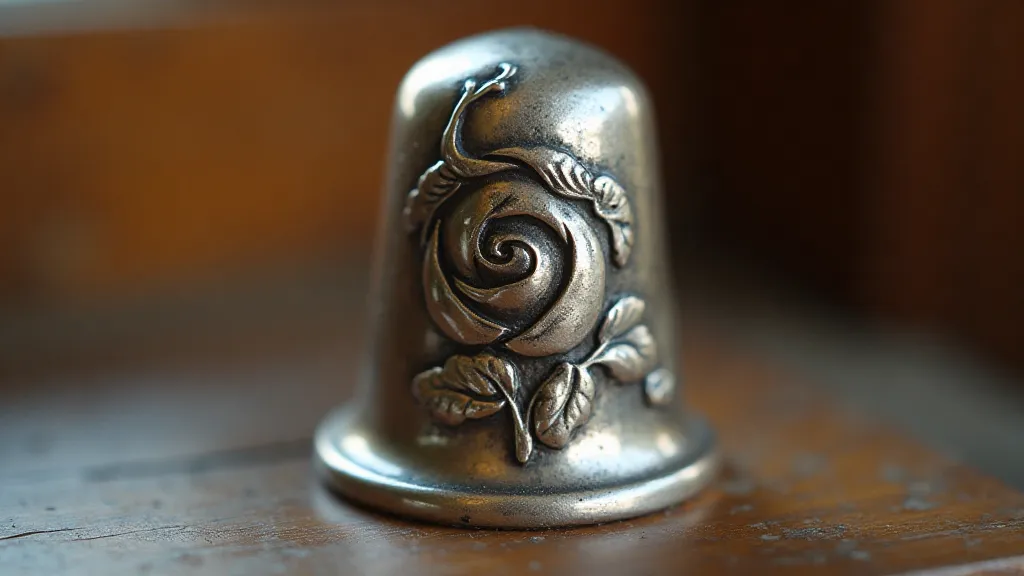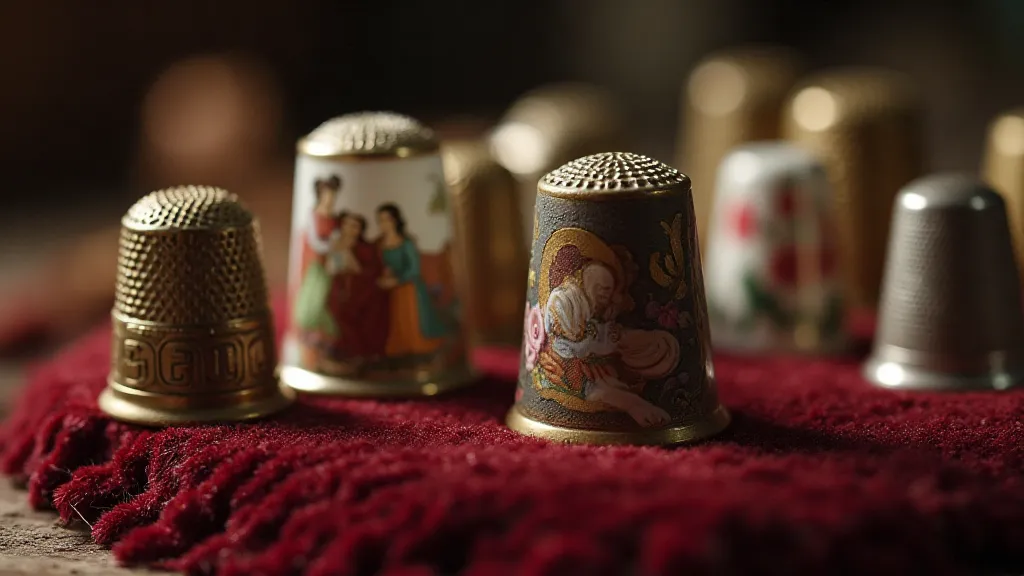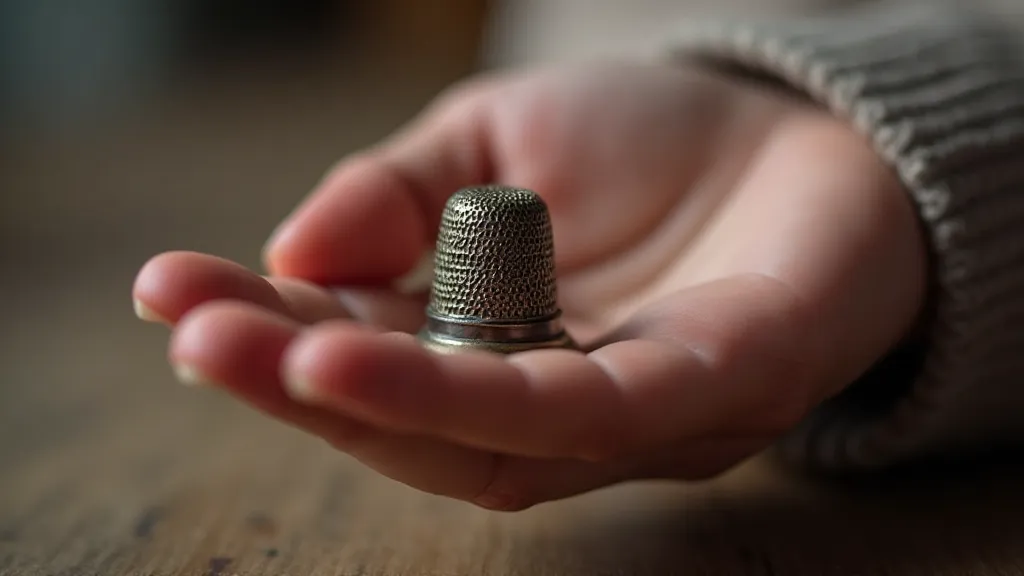The Language of Embellishment: Identifying Regional Thimble Styles
There's a quiet intimacy in holding an antique thimble. It's more than just a small, metallic relic; it's a portal to a past humming with the rhythmic click of needles and the patient dedication of countless hours spent crafting. Each thimble whispers a story, a narrative woven not just from the materials used but also from the artistic conventions and regional traditions that shaped its creation. To truly appreciate these tiny treasures is to learn to decipher their subtle language – the language of embellishment.
My own fascination with thimbles began with my grandmother, Elsie. A meticulous seamstress, Elsie’s sewing kit was a treasure trove of vintage tools, but the thimbles were always the most captivating. They weren’t just functional; they were beautiful. Each one possessed a unique character, a quiet elegance that spoke of a time when even the most ordinary tasks were approached with care and artistry. She’d tell me stories about where she thought some of them came from, tales embellished with the wistful charm of memory, and the seed of my own collecting journey was sown.
The evolution of collecting itself is a fascinating journey – from simply safeguarding tools to a deeper appreciation for their historical context and portability. It’s a shift that reflects how we value objects and the stories they tell. Thinking about how the way we carry and display these small treasures has changed over time truly adds another layer to the experience, akin to observing how the portability of thimble collections has evolved through the ages.
The English Tradition: Practicality and Floral Grace
Let's begin our exploration with the English thimble. Early English thimbles, dating from the 18th and 19th centuries, are often found in plain silver or pewter. Their design prioritised functionality; they were tools first and foremost. However, as the 19th century progressed, particularly during the Victorian era, a burgeoning middle class and an increased focus on domestic crafts brought about a shift. Floral motifs became incredibly popular, reflecting the romanticism of the era and the obsession with gardens and natural beauty. Look for subtly engraved roses, violets, or forget-me-nots – often rendered with a surprising delicacy given their tiny scale. Hallmarks are common on English thimbles, especially those made of silver, providing clues to the maker and date. The style tends towards understated elegance; practicality reigned, even as artistic expression blossomed.

German Thimbles: A Tapestry of Regional Crafts
Moving across the Channel, German thimbles reveal a fascinating diversity of styles, reflecting the country's fragmented history and varied regional traditions. The Erzgebirge region, renowned for its woodcarving and toy-making, produced a unique type of thimble—often painted with folk scenes or landscapes. These are charming, often naive in their depiction, and a testament to the region’s strong artistic identity. Southern Germany, particularly Bavaria, shows a leaning towards more ornate designs, incorporating elements of folk art and traditional costumes. Look for bright colours, whimsical patterns, and occasionally, representations of local folklore. The level of detail can be astonishing. The skill required to render such intricate designs on such a small object is truly remarkable.
During the 19th century, a significant number of German thimbles were made of pressed sheet metal, often decorated with lithographed images. These were often distributed as promotional items, and while not as intrinsically valuable as hand-wrought examples, they offer a valuable window into the advertising practices and popular imagery of the time. It's interesting to consider how color itself contributes to these narratives, influencing perception and reflecting cultural trends, as demonstrated by the language of color in antique thimble decoration. Identifying the region of origin can be challenging, requiring careful consideration of motifs, manufacturing techniques, and any visible markings.
French Thimbles: A Flair for the Dramatic
French thimbles exude a certain *je ne sais quoi* – a flair for the dramatic that sets them apart. While utilitarian examples exist, French thimbles frequently showcase a love for ornamentation. The influence of the Art Nouveau and Art Deco movements is clearly visible in many examples, characterized by flowing lines, stylized floral designs, and a sense of graceful movement. Look for unusual shapes – some French thimbles feature pointed tops or flared sides, departing from the more common cylindrical form. The use of niello – a black metallic alloy used to decorate silver – is also relatively common in French thimbles, adding a touch of luxurious darkness to the design. Many were manufactured in Paris, and bear hallmarks indicative of Parisian silver workshops.
Beyond Europe: Exploring Global Styles
The story of thimbles extends far beyond Europe. In Russia, beautifully decorated brass thimbles, often featuring scenes from folk tales or religious iconography, demonstrate a vibrant artistic heritage. Japanese thimbles, particularly those dating from the Meiji period (1868-1912), reflect the country’s rapid modernization and increasing engagement with Western styles. While traditional Japanese craftsmanship remained highly valued, Western influences can be seen in some examples, with the incorporation of Art Nouveau motifs and new manufacturing techniques. Even simpler, undecorated thimbles from various cultures speak volumes about the ingenuity of their creators and the resourcefulness needed to overcome daily challenges. The stories that thimbles tell aren't limited to simple utility; sometimes, they're intricate commentaries on society, reflecting the era’s concerns and observations, much like the thimbles as miniature stages for social commentary we see in other collections. Identifying these can be complex, requiring research into specific cultural traditions and manufacturing processes.

Furthermore, the desire to chart and understand the origins of these objects has fueled curiosity and exploration. Collecting itself becomes a journey of discovery, akin to tracing geographical routes and understanding the global interconnectedness that these tiny tools represent, leading to ideas that resonate with the spirit of thimbles as markers of geographical curiosity.
The Collector's Eye and Gentle Care
Collecting antique thimbles isn't just about acquiring objects; it's about preserving stories. It’s about understanding the context in which these tiny tools were created and appreciating the skill and artistry of their makers. When handling antique thimbles, remember that they are delicate. Avoid excessive cleaning, as harsh chemicals can damage the surface. Gentle polishing with a soft cloth can help to remove grime, but avoid abrasive cleaners. Proper storage is also essential; protect thimbles from scratches and tarnish by storing them in individual compartments or padded pouches. The significance of these objects extends beyond their material value; they offer a glimpse into the lives and skills of past generations, providing a unique lens through which to examine history and understand human creativity.
Research is key to truly understanding your collection. Consult reference books, online forums, and connect with other collectors. Each thimble holds a secret, a piece of the past waiting to be uncovered. And with each discovery, the language of embellishment becomes clearer, the stories richer, and the appreciation for these miniature marvels grows ever deeper. The value of a collection isn’t solely determined by rarity or cost; it’s in the connections we make, the knowledge we gain, and the stories we share. It's a pursuit that can span continents and generations, bringing together individuals who share a passion for these small but significant artifacts.
My grandmother Elsie would be pleased to know that her passion for these little treasures continues to inspire. The quiet click of a needle, the feel of a thimble against one’s finger—these are sensations that connect us to generations past, a testament to the enduring power of craft and the beauty of the handmade. The continued pursuit of understanding and appreciation for these artifacts ensures their survival and allows future generations to marvel at their beauty and ingenuity, guaranteeing that their stories will continue to be shared and cherished for years to come.






